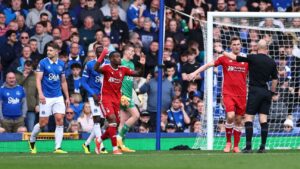Keylor Navas form, status means Thibaut Courtois not an instant pick at Real Madrid


When Gareth Bale ripped through the Girona defence on Sunday night to give Real Madrid a 3-1 lead at the home of their Catalan opponents, Sergio Ramos and Nacho celebrated passionately.
Little surprise you might think, given the goal effectively sealed victory from a game in which the European champions had fallen behind. However, while their white-shirted teammates leapt on Bale some 100 metres away in the far-left corner of the Estadi Montilivi, the defenders ran in the opposite direction, to goalkeeper Keylor Navas.
Ramos and Nacho were not celebrating the goal or its scorer, per se; they were putting on a demonstration of the strengths and threats that lie in front of new manager Julen Lopetegui. This was a show of how strongly Madrid’s senior leaders feel about Navas, his reliability and the threat he is under following the arrival of Thibaut Courtois.
It is possible that those watching on TV did not see this subplot play out, so let me explain why it was that the captain and his central-defensive partner turned and ran toward their goalkeeper and, in doing so, laid out a challenging, potentially make-or-break conundrum for their new boss.
You know by now that Madrid do not have a Director of Football, which means that club president Florentino Perez, considers himself a de facto DoF. Signings carry his personal stamp and, as such, he is liable to feel strongly that his latest purchase should play, automatically and immediately. Therefore, he is liable to be miffed if a coach, particularly a new one, defies him by leaving a shiny new purchase on the bench.
Step forward, Courtois.
To understand what kind of pressure Lopetegui should be feeling, cast your memory back to Rafa Benitez’s first Clasico, against Barcelona in November 2015 and, for Courtois, read Danilo.
Perez indicated to his manager that, when he was picking the team, there should not be any debate at right-back: Danilo was the “best in the world” in the position and should be the first name on the team sheet every week.
Meanwhile, back in the real — rather than Real — world, it was obvious to anyone who actually knows football that a) Danilo was decidedly raw, positionally naive and not close to Dani Carvajal’s competitive or technical level and, b) Casemiro was the rock around which Madrid’s midfield had to be built, even if he was not much appreciated by the Madrid president in comparison to James Rodriguez
Benitez played to the gallery, figuring that keeping his boss happy was a good way to ring-fence his continued employment. Therefore, Danilo played at right-back against Barcelona in the Bernabeu, with Carvajal and Casemiro on the bench.
Madrid lost 4-0, Isco was sent off and the home team’s fans chanted “Florentino resign” and “Florentino out!” so loudly that the stadium manager had to turn up the post-match music to near-deafening levels in order to drown out the mutiny.
Just over five weeks later, Benitez was sacked.
Almost three years on, Courtois is the latest presidential project, after the club tried to add Kepa Arrizabalaga from Athletic Bilbao in January only for Zinedine Zidane to state publicly — that another keeper was not needed.
It was a warning shot from a powerful manager to his headstrong president and foreshadowed what was to come: The issue of Navas being unnecessarily undermined was one part of Zidane’s calculations when he decided to quit his job in May, just days after retaining the Champions League in Kiev.
Courtois has added cachet for Perez and not simply because he had a terrific World Cup in Russia, as Belgium achieved a best-ever finish of third, nor that he is a Premier League title winner with Chelsea.
It is important to add into the equation that the 26-year-old made his name at Atletico and became a thorn in Madrid’s side as soon as Diego Simeone took over at the Vicente Calderon stadium. Courtois was a central figure in ensuring Jose Mourinho’s last match in charge of Los Blancos, the 2013 Copa del Rey final, ended in defeat and was a fundamental part of Atletico’s Liga-winning team the following campaign.
Big clubs love to kick the shins of rivals and the notion that “we’ve got your man on our books” is a time-honoured piece of one-upmanship. As such, it is understandable that Perez is keen to see Courtois in competitive action, particularly with the Madrid derby just over a month away.
So Lopetegui, an ex-keeper who played just once for Madrid before being dropped and subsequently sold after conceding three goals in a derbi draw, has chosen to play a moderately dangerous game, at least regarding the relationship with his president, by keeping faith with Navas and sticking Courtois on the bench.
Hence the fascinating nature of what happened just before 11:30 p.m. on Sunday in Girona.
Navas had already made some notable saves by the time Madrid’s 2-1 lead was threatened by Portu sprinting through, one-on-one vs. the Costa Rican international.
Portu, the Valencia-developed 26-year-old, is lightning-quick and scored the winner against Madrid last season, meaning he was the last person Ramos and Nacho would have wanted to see behind them and hurtling toward their goal.
Navas’ reactions were electric; despite having started at a disadvantage, he won the foot race to get to the ball first and hoofed it clear.
One minute later, another Girona move foundered as Navas collected a Portu cross, whereupon the under-threat keeper took a quick glance and hurled the ball half the length of the pitch, right onto Isco’s wonderful right foot.
The midfielder’s second touch released a slide-rule pass inside Marc Muniesa for Bale, who galloped past the left-back, collected possession and clinically curved a shot around Bono and into the Girona net.
It took 12 seconds from the catch at one end to a goal at the other: brutal, brilliant and Navas-inspired. No wonder Nacho and Ramos — individually rather than having made a mutual decision — sprinted joyfully to embrace their goalkeeper in gratitude for having repeatedly kept Madrid in the game, then topped his performance with what almost constituted an assist to Isco.
Madrid would go on to win 4-1 as Karim Benzema scored his first league double for 18 months, but not before Navas made two more remarkable saves, one of which was utterly spectacular as he dived high to his right to tip away Alex Granell’s left-footed volley.
As Nacho and Ramos trotted upfield to pat Bale on the back, Navas retired to the back of his goal, put each arm up high in a spread-eagled position and said a brief prayer. I do not know whether his faith is what has kept him strong while his position has been threatened by presidential efforts to sign David De Gea, Kepa and Courtois, but my admiration for his competitive spirit and calm temperament knows no bounds.
Meanwhile, poor old Courtois sat on the bench, possibly realising what kind of battle he has walked into, looking very glum. In due course, Lopetegui will choose one of them for the Champions League and Copa del Rey and one for La Liga.
Such an approach can work, as Barcelona proved when they owned Claudio Bravo and Marc-Andre ter Stegen and pitted them against each other in 2014-15: Bravo won them the Spanish title while Ter Stegen was in between the posts for the other two parts of a treble triumph.
Lopetegui was quite right, after Sunday’s game, to call the situation a positive opportunity rather than an automatic problem. However, if he was not handling the issue deftly and if Navas was not reacting with such outstanding diligence and bristling competitive aggression, then Madrid could easily be suffering instead of thriving.
Source link







Leave a Reply
You must be logged in to post a comment.